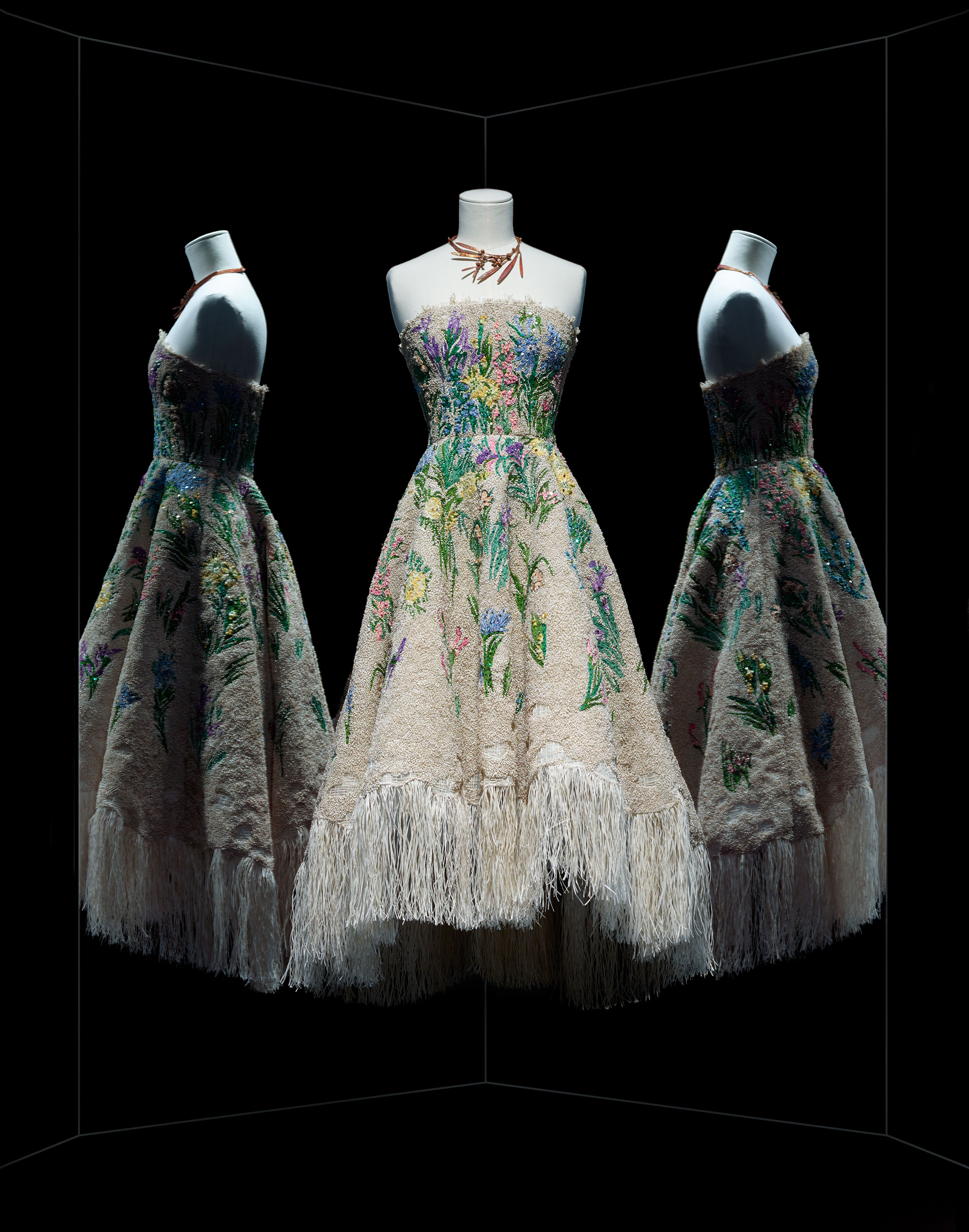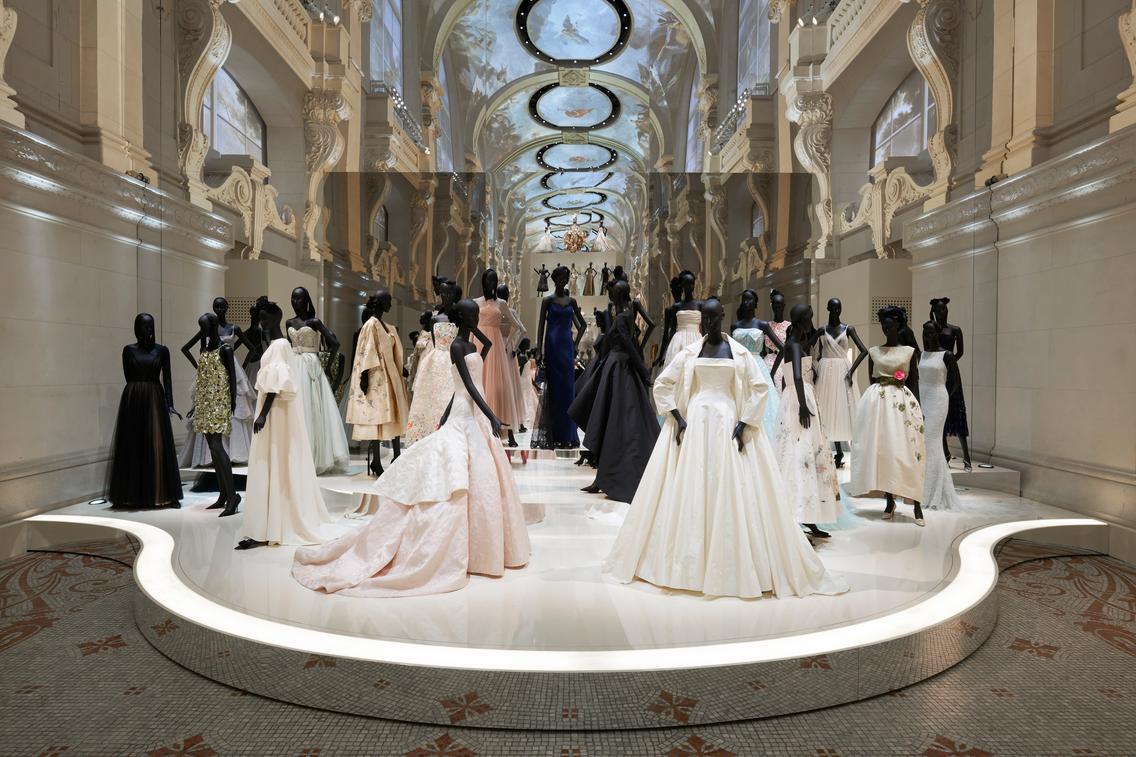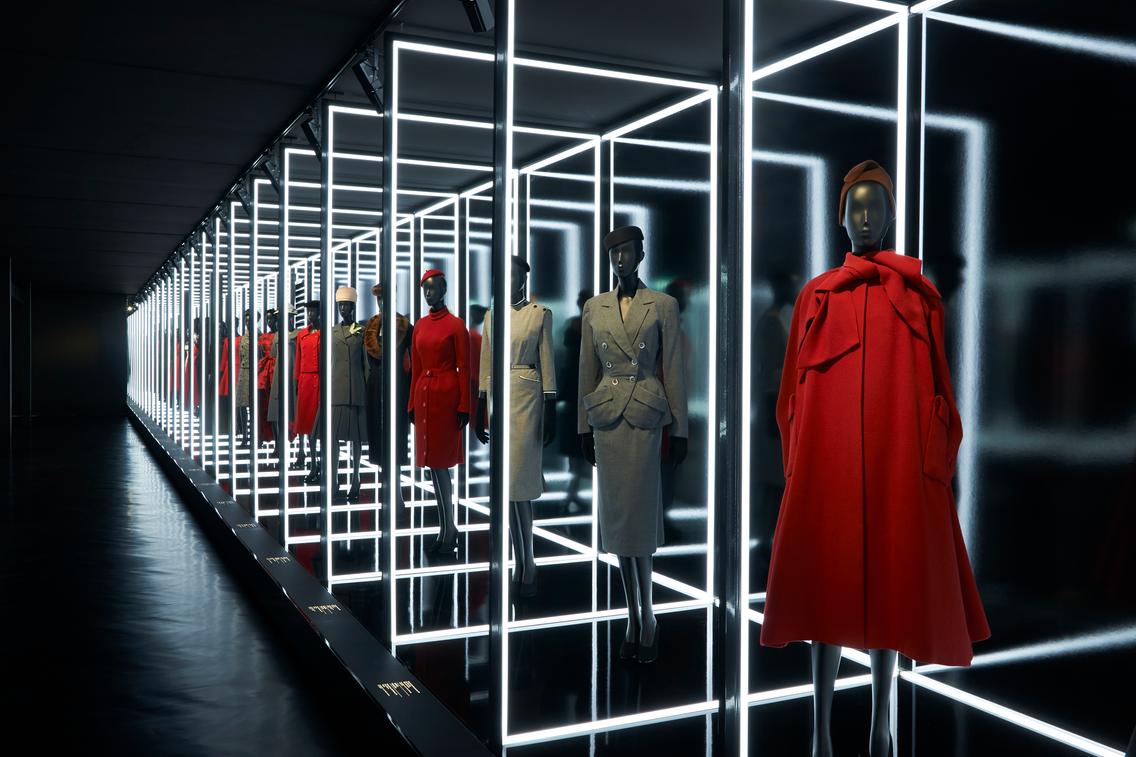Exhibition Review: Dior: Designer of Dreams
Musée des Les Arts Décoratifs (Paris), July 5, 2017 – January 7, 2018
2017 marked the 70th anniversary of the founding of the House of Dior and it thus seems inevitable that a blockbuster exhibition detailing its history would be hosted in couture’s home city of Paris, at the Musée des Les Arts Décoratifs. Christian Dior, Couturier du Rêve was presented on a monumental scale, covering 3,000 square feet with upwards of 300 outfits and 1,000 accessories on view. A sweeping overview of Dior’s work would hardly be sufficient for one of the preeminent couturiers, and brands, of the 20th century. Nor would an examination of Christian Dior himself be appropriate, despite the title’s suggestion of a single designer of dreams. Therefore, this exhibition took the House of Dior as a whole entity, with particular characteristics brought by its diverse crop of lead designers but with a fundamental identity and ability to amaze.
The exhibition was curated by Olivier Gabet and Florence Müller, and the integral, inspired exhibition design was led by Nathalie Criniére. To recognize scenography alongside curation is at the heart of the exhibition’s success because, though the vast majority of objects come directly from the House of Dior Heritage Collection, it feels nothing like an archive presentation. It avoided the fate of other heavily sponsored, single designer exhibitions like Commes des Garcons: Art of the In-Between (2017), where the atmosphere was more akin to the houses’ storage facility. In Designer of Dreams, the scope remained primarily visual — presenting fashion objects without vast amounts of textual accompaniment and, crucially, drawing parallels across its history. In the case of a designer so well known, one of the exhibitions greatest offerings was an opportunity to see so much documented and preserved history in one place. It engaged the visitor in great admiration of Dior without needing to learn anything more about the man or the business. Though contributions to fashion history are necessary and welcome, for Dior there is much already available and this exhibition was simply, in a most ostentatious setting, a celebration of a pinnacle of fashion.
The exhibition successfully achieved its intended scope to present 70 years of couture offerings from the House of Dior, rather than focusing on Christian Dior as a singular designer. The galleries focused on unifying elements across the eras of Dior, successfully incorporating the work of Dior’s head designers. So much so that the exhibition title proved problematic, as it was so clearly not focused on a single designer but instead worked to draw connection on the emotion, inspiration and legacy of each figure. Indeed, it was striking how the fundamental characteristics of the Dior brand have prevailed, rooted in the spirit of its origins.
The exhibition incorporated a staggering amount of archival, textile and contemporary material. The set design, lighting and continually changing environment spanned the entire museum, creating a truly sensory experience. The first section was arranged thematically with garments displayed under cascading paper flowers as though in a garden, alongside Asian artworks, or within an 18th century drawing room. Most remarkably, the eras of Dior spanning 70 years blended without fault, even though each lead designer warranted individual consideration in later rooms. As the accompanying book notes, “[they] have all drawn on their own creative sensibilities to formulate a style and a vocabulary that stay true to the original concept and to help define the House of Dior’s identity through the prism of its relationship to its era.” [1] This was demonstrated When gathered together in the same room there was hardly any telling apart the generations of Dior.
A demarcated area within the exhibition considered Christian Dior’s early life, introducing his roots in the art world, and the gallery he ran from 1928-1934. While the exhibition as a whole considered “the art of living” as a principle of his approach to art, design and later fashion, [2] this small, historical gallery also included some of the most iconic early Dior pieces alongside projections of the images that made them famous. This curatorial choice portrays the creative synergy between visual culture objects from the archive and their position in history. Couture customers are a small group yet these pieces and images are famous worldwide, and this exhibition was considerate of both the object and its reception.
It is perhaps impossible to discuss Christian Dior as a fashion designer without reference to his 1947 collection that is now synonymous with post-war recovery. Though it opened in a reflection of his early life, the exhibition addressed Dior as a purveyor of this historical shift. The exhibition thoughtfully portrayed the spirit and founding principles of Christian Dior and his immense role in mid-century fashion, despite large proportions of the objects coming from other head designers.
The sprawling exhibition primarily served as a visual showcase of the Dior Heritage Collection in its Paris heartland and it portrayed the fashion house through its output, moreover unveiling new scholarship. The historical consideration of Christian Dior’s connection to art was positioned as an introduction, supporting the uninitiated attendee before unleashing them into the sensory spectacle. Though there is always opportunity to advance fashion scholarship, the setting of this exhibition justified it as an exploration of fashion objects viewed in little more context than their creation and creator —allowing the visitor to become immersed in the world of Dior and appreciate the beauty and technicality of its couture output while developing admiration for the brand. Dior’s legacy was not overstated and instead was proven by a well-considered and frankly stunning exhibition.
Though the outfits on display, primarily dresses, showed the design range of Dior, it was in the section named ‘The Colourama’ where the immense achievement and scope of the House was made clear. In curving glass cases thousands of photographs, accessories, drawings, hats, jewelry, perfume and advertisements were arranged in a sweeping color spectrum. It was a display technique more vast, fascinating and intricate as any recent fashion exhibition and worked to further commend Dior as having a story to tell through the objects alone. The innovative display handled the challenge of showing secondary materials that do not hold the weight or iconography of clothing proper. It remained connected to the best-known creations by including miniatures of scores of dresses seen in full actuality at other points. In a similar vain to the Cabinet of Curiosities from Alexander McQueen Savage Beauty (2011), the colourama was not an overt presentation of historical context, but an opportunity to appreciate the materiality of fashion and fashion-related ephemera.
Towards the end of the exhibition there was an, unfortunately, cramped and poorly constructed zigzag corridor progressing through specific displays for each lead designer. The congestion made viewing the pieces or reading information difficult, yet the preceding galleries were so successful in projecting a unified Dior that the separation seemed almost counter-intuitive and this misstep was easily forgotten. Disorientated by countless successive rooms, it was easy to assume that a long, dark corridor lined with Dior’s best skirt suits and coats was the final gallery, showcasing the New Look as the foundation and sustaining power. Yet a final turn brought visitors into ‘The Ball’, a lofty, palatial gallery filled with grand music and a stunning display of Dior evening wear. Reminiscent of a Parisian ballroom, a glittering collection of Dior’s finest dresses rose three stories tall in a dramatic and spectacular end to an exhibition that was arresting to the senses and, as fashion should be, fundamentally about its visual quality. The rich history of the house and its head designers is evident in the accompanying book and to some degree throughout the exhibition. Les Arts Décoratifs and the curators, however, understood that the great power of Dior is in its beauty, variety, and spectacle and there need be little else said about it.
Notes
[1] Müller, Florence. (2017) Christian Dior, Couturier du Rêve, MAD Paris [online], available: http://madparis.fr/en/exhibitions/current-events-1322/musee-des-arts-decoratifs/christian-dior-couturier-du-reve
[2] Müller, Florence. (2017) Christian Dior, Couturier du Rêve, MAD Paris [online], available: http://madparis.fr/en/exhibitions/current-events-1322/musee-des-arts-decoratifs/christian-dior-couturier-du-reve





